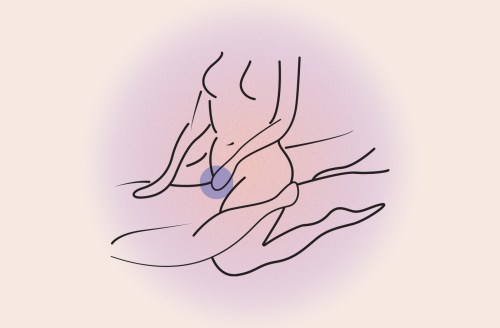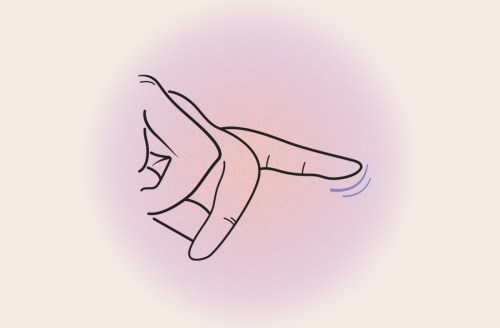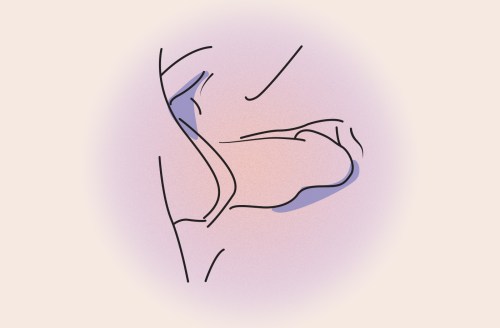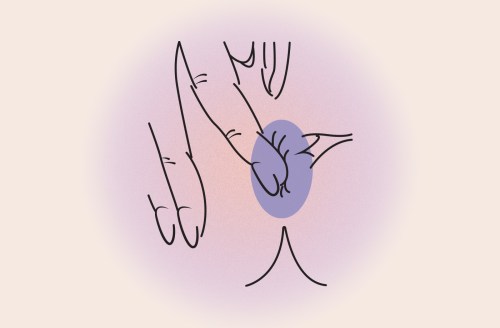Our editors independently select these products. Making a purchase through our links may earn Well+Good a commission
When it comes to penetrative sex, if you’re looking to switch things up, you might initially think to try out a few different sex positions. But that’s certainly not the only way to add some spice to your sex routine. You can also change up the literal way that you’re having sex. That’s right, there are plenty of different sexual penetration techniques that’ll give the regular in-and-out a run for its money.
Experts in This Article
former research scientist at OMGyes
Arkansas-based gynecologist, intimacy expert, and sexual wellness doctor
sex educator and co-founder of GoLove CBD lubricant
sex and relationships expert, author, and public speaker
To be clear, penetration is just one part of the sexual picture; after all, fewer than 20 percent of respondents reported orgasming from penetration alone1 in a nationally representative survey of about 1,000 vulva-owners conducted in 2015. Let’s not forget that clitoral stimulation is typically the fastest route to orgasm for vulva-havers, and non-penetrative sex acts are a totally sufficient way to get there.
Even so, some kind of penetration is often involved in intercourse and can be sexy and satisfying in its own right—particularly when you experiment with sexual penetration techniques. “There’s something about penetration that allows partners to feel even closer to each other [than with non-penetrative sex], and it’s almost like a bonding practice for a lot of people,” says sex and relationship educator Tara Suwinyattichaiporn, PhD (who goes by Dr. Tara), professor of relational and sexual communication at California State University Fullerton and host of the Luvbites by Dr. Tara podcast.
“There’s something about penetration that allows partners to feel even closer to each other.”—Tara Suwinyattichaiporn, PhD, sex educator
If you think about it, that makes sense: Plenty of penetrative sex positions put you and a partner into a position that resembles cuddling, which releases the feel-good hormone oxytocin. “This is why some people might blurt out ‘I love you’ during penetrative sex,” says Dr. Tara.
Paired with the stimulation of other erogenous zones, penetration can also just level things up a notch by allowing for multiple or blended orgasms, says Dr. Tara. And experimenting with speed can bring about a host of different sensations, too; for example, slow and deep penetration can really amp up feelings of bonding and target harder-to-reach pleasure zones like the G-spot.
But putting pace and positions aside, exploring different sexual penetration techniques—whether with a toy or a partner—is one surefire way to get the most out of any penetration you might be doing. Below, find 11 sexual penetration techniques to try from our friends at OMGyes, a sexual-education platform aimed to help vulva-owners maximize their pleasure.
11 sexual penetration techniques to try for boundless pleasure
1. Shallowing

Shallow penetration, or shallowing, is essentially a strategic take on “just the tip in” that includes different ways of stimulating the first inch of the vaginal entrance. According to sexologist Sadie Allison, PhD, co-founder of GoLove CBD lubricant, you can tap into a whole lot of pleasure endings without ever wading into the deep end.
“The majority of the nerves in the vagina are in the first third, so that area is hyper-sensitive, and can often be more receptive to touch—making shallow penetration particularly pleasurable,” she says. “The head of the penis is also more sensitive, containing 4,000 orgasmic nerve endings that trigger climax, than the shaft, so this technique can hyper-concentrate sensation [for both parties].”
2. Pairing

ing focuses on different ways to stimulate the clitoris during penetration. “While less than 20 percent of women experience orgasms during penetration without any clitoral stimulation [per the study above], about four times as many women say that clitoral stimulation during intercourse is either necessary for orgasm or makes their orgasms better,” says Christiana von Hippel, ScD, former research scientist for OMGyes.
In addition to using hands, a small vibe can help with pairing clitoral stimulation with penetration. Think: a chic, subtle wearable like Crave’s Vesper Vibrator Necklace ($69).
3. Staying in

Staying in refers to the ways in which two pelvises can stay in contact and grind together instead of moving in and out. This sexual penetration technique embraces the stimulation of friction, and there are several motions and angles that can elevate the experience.
“The muscle group your kegels are flexing or squeezing are the pubococcygeus muscles, aka your orgasm muscles,” says Dr. Allison. “The penis-owner can literally feel your PC muscles squeezing their penis if you both stay still and you squeeze. You can feel the penis-owner do it, too, as both genitalia have the same orgasm muscle.”
4. Broadening

This is all about applying wider, thicker pressure to the clitoris during penetration instead of poking at it, which can sometimes be a little too intense. To try it, someone can start rubbing the vulva with the tip of the finger, then the pad of the fingers, then two or three fingers spread.
This method also works with a toy or penis, or even during oral sex. A technique like the Kivin Method (aka horizontal oral) has the tongue flat and broadened over the vulva, which can have the effect of making someone climax in a few minutes flat.
5. Flexing

Put those kegels to work! Flexing is a penetration technique that involves squeezing the vaginal muscles as if to egg on an orgasm. And, heads up: Sometimes this can lead to an orgasm lasting longer.
“This motion with the vulva can lead to a slow-build orgasm,” says Dr. Allison. “Flexing your kegels also strengthens them, which has been shown to lead to more pleasurable sex and stronger orgasms.”
6. G-region

This technique calls upon the G-spot, which OMGyes outlines as more of a region than a go-to pleasure button. The G-region is understood to be approximately a few inches deep on the front or top wall of the vagina, but instead of searching for a specific “spot,” you want to stimulate the area until you feel something. A toy like Dame’s Arc ($115) is perfectly curved to target the top wall and find what stirs someone.
7. Angling

This refers to ways that partners can tilt their pelvises to direct more pressure to the clitoris or G-region. To reap the full benefits of angling, consider getting yourself a sex pillow. An angular, sturdy cushion like Dame’s Pillo ($95) can help someone adjust the depth of penetration and redirect the penetration to hit your more covert erotic spots.
8. Renewing

The first moment of penetration can feel exciting because of the highly anticipated “oomph” feeling, but the repetition of moving in and out can become routine. Renewing involves taking a prolonged sexual intermission that can make restarting penetration feel like the first time and build intimacy by adding a teasing element to your sex play.
“The action of pausing also allows us to take ourselves out of the ‘goal-oriented’ narrative that often comes with sex, especially p-in-v penetrative sex,” says Dr. Allison. “It gives us a chance to pause, take note of our emotions and sensations, and mix up the script rather than race to the finish.”
9. Booty

This is all about bringing anal stimulation into sex play, which can bring about its own dose of pleasure thanks to all the nerve endings in the butt. There are plenty of ways to do that, including manual stimulation, or you can introduce a toy into the mix. A luxe vibrating butt plug like the b-vibe Rimming Plug Petite ($145) can simulate rimming (ahem, that’s anal oral) while someone is being simultaneously penetrated.
10. Adding

Adding is about, well, adding into the vagina to provide a sense of fullness. You can accomplish this with digital penetration, by adding additional fingers, orby using compatible toys. The We-Vibe Sync ($149), for example, can be inserted internally as a companion to p-in-v penetration and can (joyfully) provide clitoral vibrations at the same time, as can the Satisfyer Partner Whale ($16).
11. Deep end

Deep-ending refers to reaching a vulva-owner’s cervix. Before trying it with a partner, though, sexperts recommend that you test the waters on your own with a long, G-spot-reaching toy like the We-Vibe Rave ($119). And when going at it with a partner, be sure to wait until you’re fully aroused and to use ample store-bought lube for smooth sailing.
Frequently Asked Questions About Sexual Penetration Techniques
Why can’t I have penetrative sex?
It might be difficult to have penetrative sex due to your unique anatomy. “Everyone is built uniquely and also has their own experience of pleasure and pain,” says gynecologist and sexual medicine specialist Christie Cobb, MD. Specifically, the uterus (and therefore the cervix) can be positioned “either more anteriorly or posteriorly, which can cause certain angles of penetration to be more pleasurable or more painful,” she says.
Dr. Cobb recommends gently and consensually experimenting with different sexual penetration techniques, positions, and angles to figure out what may work best for you and a partner.
If any kind of penetration feels restrictive, you may also be facing a hypertonic (or overly tight) pelvic floor. In this case, using vaginal dilators—which are akin to dildos but designed to stay in the vagina and stretch, loosen, or mobilize the pelvic floor—can help you increase the flexibility of your vagina and more comfortably accommodate penetration, says Dr. Tara.
Why does penetration hurt?
There are a variety of potential physical and psychological reasons for vulvar, vaginal, and pelvic-floor-related pain during sex, including certain medical conditions like vaginismus, endometriosis, urinary tract infections (UTIs), and sexually transmitted illnesses (STIs) like gonorrhea or chlamydia. An OB/GYN can help you figure out if the pain you’re having during penetration may be tied to one of these medical conditions, and if it is, offer you treatment.
At the same time, pain with penetration can also be caused by a lack of sufficient lubrication and the resulting friction, which can also cause tears within the vaginal or anal canal or overstretching of the ligaments in either region, says Dr. Cobb.
That’s why it’s super important to make sure that you’re aroused and fully lubricated and to use store-bought lube (particularly for anal) before engaging in any sort of penetration. Easing the toy or penis in slowly can also help minimize pain, says Dr. Cobb.
Dr. Tara adds that for some people, pain with penetration can be psychological. “Someone might just think of penetration, and it already hurts, which could be the result of sexual trauma or anxiety,” she says. In this case, seeking the support of a sex therapist can be of major help.
In the meantime, Dr. Tara also recommends sexual mediation as a way to “relax the body and [vulva] so they can receive penetration more easily.” To do this, take some time each day to visualize a penetrative sex experience that’s pleasurable and positive rather than painful, she suggests. Putting this image in your mind can help you develop a positive mental association with penetrative sex, which can, over time, change your physical experience of it, too.
Can you bleed if your partner goes too deep during penetration?
Deep penetration can result in bleeding if the vaginal or vulvar tissue is torn, says Dr. Cobb. “Even microtears can cause discharge to have a light blood tinge,” she says. These kinds of tears can certainly cause pain after sex, too, even if they aren’t anything to worry about on the medical front.
If you have a friable cervix, which basically means it’s more sensitive when touched, you can also have bleeding or spotting during or after deep penetration, and pregnant people are more prone to this, too. The important thing to note is that most instances of light post-sex bleeding will resolve on their own, but if you notice any bleeding that is unusual for you or that is heavy and accompanied by pain, be sure to check in with your OB/GYN.
What does someone feel when you hit their cervix?
Intense pressure is the most common feeling that someone might experience when their cervix is hit during deep penetration, says Dr. Cobb. The cervix has three types of nerve endings, meaning any kind of contact can come with a variety of sensations.
“Some people like [cervix contact] and even have cervical orgasms, and some people don’t, and just find it irritating or unpleasant,” says Dr. Tara. If you’re experimenting with deeper p-in-v penetration and have a cervix, be sure to communicate with your partner about what feels good and what doesn’t.
As for whether it’s dangerous to hit someone’s cervix? Dr. Cobb says a bump or even a bruise isn’t dangerous, unless it’s during a high-risk pregnancy. “Cervical stimulation should be avoided with preterm labor or cervical dilation or shortening as well as with placenta previa, which is a condition where the placenta covers all or part of the cervix,” she says.
That said, if you’ve had penetrative sex that involved your cervix being hit and you’re in pain, it’s important to check in with your OB/GYN.
Herbenick, Debby et al. “Women’s Experiences With Genital Touching, Sexual Pleasure, and Orgasm: Results From a U.S. Probability Sample of Women Ages 18 to 94.” Journal of Sex & Marital Therapy, vol. 44, no. 2, 2017, https://doi.org/10.1080/0092623X.2017.1346530.
↩︎
Sign Up for Our Daily Newsletter
Get all the latest in wellness, trends, food, fitness, beauty, and more delivered right to your inbox.
Got it, you've been added to our email list.










